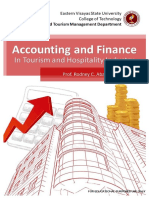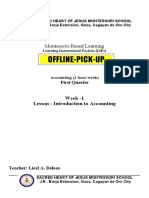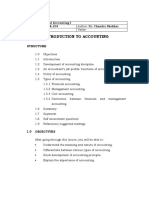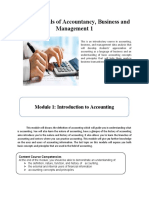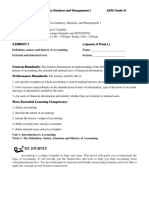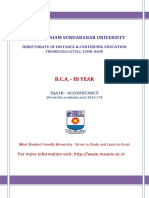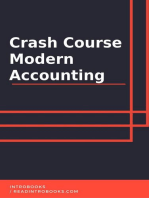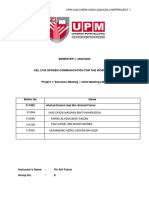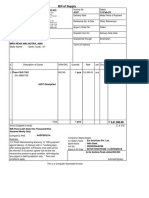Acctg Module 1
Acctg Module 1
Uploaded by
pearlyCopyright:
Available Formats
Acctg Module 1
Acctg Module 1
Uploaded by
pearlyOriginal Title
Copyright
Available Formats
Share this document
Did you find this document useful?
Is this content inappropriate?
Copyright:
Available Formats
Acctg Module 1
Acctg Module 1
Uploaded by
pearlyCopyright:
Available Formats
Mt. Carmel College of San Francisco, Inc.
8501, San Francisco, Agusan del Sur, Philippines
Tel. No. (085) 839-2161 • e-mail: mccsf.registrarsoffice@gmail.com
Fundamentals of Accounting &
Management 1
Source: iEduNote.com
This is an introductory course in accounting, business, and management data
analysis that will develop students’ appreciation of accounting as a language of
business and an understanding of basic accounting concepts and principles that
will help them analyze business transactions. (Source DepEd CG)
Fundamentals of Accounting, Business & Management 1 - First Semester, SY 2020-2021 |1
Mt. Carmel College of San Francisco, Inc.
8501, San Francisco, Agusan del Sur, Philippines
Tel. No. (085) 839-2161 • e-mail: mccsf.registrarsoffice@gmail.com
SENIOR HIGH SCHOOL LEVEL
School Year 2020-2021
Subject Fundamentals of Accounting & Management 1
Grade Level Grade 11 Section
Semester First Semester Quarter 1
Module No. 01 Chapter No. 1
Lesson No. 01 Date Week 1
Content The learner demonstrates an understanding of the definition, nature, function, and
Standard history of accounting
Performance The learner shall be able to cite specific examples in which accounting is used in
Standard making business decisions.
Learning The learner…
Competencies 1. define accounting
2. describe the nature of accounting
3. narrate the history/origin of accounting
At the end of the lesson, the learners will be able to:
Specific
Learning 1. define accounting
Outcomes 2. describe the nature of accounting
3. explain the functions of accounting in business
4. differentiate bookkeeping and accounting
5. narrate the history and origin of accounting
Introduction
Accounting is an old discipline that dates back to thousands of years but the one closet to what we
now have dates back to 1400 in Italy. The Italian mathematician, scholar and philosopher Fra Luca Pacioli
published Summa de Arithmetica, Geometrica, Proportioni et Proporcionalita in 1494. It contain
descriptions of the practice of accounting at that time. Because of this work, Pacioli has been referred to
as the “Father of Accounting.”
Accounting is defined as an information system that measures, processes and communicates
information, which are primarily financial in nature, about an identifiable entity for the purpose of making
economics decisions. Accounting has been referred to as the language of business because it is the
communication link between the entity and the users of financial information. These users of financial
information are decision-makers. These decisions-makers are the management of entity, the employers,
the investors, the lenders, the government and consuming public.
Fundamentals of Accounting, Business & Management 1 - First Semester, SY 2020-2021 |2
Mt. Carmel College of San Francisco, Inc.
8501, San Francisco, Agusan del Sur, Philippines
Tel. No. (085) 839-2161 • e-mail: mccsf.registrarsoffice@gmail.com
The accounting information system starts with the business activities that are documented.
The documented businesses are measured in terms of money. They are called the supporting documents
for the transactions and economic events.
Pre-Activity
After graduating from high school, Jose Mercado decided to put up a photocopying business
because there was none near the vicinity of the school. Students had to walk far just to nearest
photocopying center. Jose knew that the demand for photocopying services among high school students is
high because teacher after assign readings and lecture notes that should be photocopied.
Jose opened his photocopying business on July 1, 2015. He rented a commercial space located in
front of the High School fate for Php 5,000.00 per month. He also borrowed Php 50,000.00 in four years.
From his personal savings, Jose spent Php 10,000.00 for supplies like bond papers, staplers, paper clips,
and other supplies that he would need in his business. He also paid Php 2,000.00 for business permits and
licenses. And because Jose had to attend to his classes in a nearby university, he hired a staff with a
weekly salary of Php 1,000.00 to operate the business Jose plans to visit his photocopying shop after his
class every day to check on it.
Analysis
In determining the profit of the photocopying business, Jose did the usual cash-in versus cash-out
technique. This technique involves grouping of cash movements into cash-in and cash-out and simply
getting the difference between the two. This technique may suffice for now but he should really gather
financial statements that indicate the correct financial position and financial performance of his business.
However, determining the net profit takes more than just adding the cash-in and cash-out.
Business Transactions
Business transactions take place once a business ventures starts operation business transactions
are the interaction business and other stakeholders, stakeholders, include but not limited to, customers,
suppliers, investors, and government office. This transaction can be very simple like buying
photocopying supplies or very complex like applying for a bank loan that requires submission of
business and legal documents. Business transactions have to be identified, measured and documented
through an accounting process. Doing so can make easier for the owner and managers to prepare
financial statements for a particular period or as of a specific time.
Definition of Accounting
There are three widely – accepted definitions of accounting.
Fundamentals of Accounting, Business & Management 1 - First Semester, SY 2020-2021 |3
Mt. Carmel College of San Francisco, Inc.
8501, San Francisco, Agusan del Sur, Philippines
Tel. No. (085) 839-2161 • e-mail: mccsf.registrarsoffice@gmail.com
According to American Accounting Association (AAA), accounting is the process of
identifying, measuring and communicating economic information to permit informed judgment and
decisions by users of the information.
However, the American Institute of Certified Public Accountants (AICPA) defines accounting as
the art of recording, classifying and summarizing the results thereof.
And lastly, the Accounting Standards Council (ASC) see accounting as a service activity. Its
function is to provide quantitative information, primarily financial in nature, about economic entities,
that is intended to be useful in making economic decisions.
Nature of Accounting
From the three definitions above, we can see the unifying themes that describe the nature of
accounting. Accounting is an art, the word “art” refers to the design of how something can be
performed. It is a behavioral knowledge involving creativity and skill. By the very nature that
accounting activity is systematic, it has definite technique and its proper application require a
particular skill and expertise.
Moreover, accounting deals with transactions that are financial in nature. The definition of ASC
requires that business transactions have to be measured in terms of money. All other transactions that
are non-monetary are not within the scope of accounting.
It can be also be deduced that accounting is a process. A “process” is a systematic serves of
actions directed toward a particular outcome. As a process, accounting performs specific actions such
as identifying, measuring, and communicating financial information. It has to follow logical steps in
the accounting cycle like recording, classifying, and summarizing financial transactions, and
communicating the results after.
In effect, accounting is also an “information system.” An information system is a set of
interrelated components that work together to achieve a common purpose. It also serves as a repository
of collected financial data, proposed financial information, and communicated financial statements.
Moreover, accounting is a means and not an end. Although accounting has a tangible output in
the form of financial statements, it still underscores the users have the liberty to make economic
decisions based on the management assertions in the financial statements. Using this logic, accounting
indeed paves the way to end and it is not the end itself.
For businessmen, entrepreneurs, managers and stakeholders, accounting is a service activity. It is
concerned with providing the service of ensuring that financial statements are made available to users
on a timely basis.
Functions of Accounting in Business
Fundamentals of Accounting, Business & Management 1 - First Semester, SY 2020-2021 |4
Mt. Carmel College of San Francisco, Inc.
8501, San Francisco, Agusan del Sur, Philippines
Tel. No. (085) 839-2161 • e-mail: mccsf.registrarsoffice@gmail.com
The functions of accounting in business can be attributed to the three fundamental objectives of
an information system. An information system in itself, accounting performs to following tasks.
1. To fulfill the stewardship function of the management (or owner).
2. To help interested users come up with informed decisions.
3. To support daily operations of the business.
These tasks validate why accounting is considered as the language of business. It serves as
means of communication between the business and interested users whether internal or external. It
facilitates the smooth flow of information in and out of the business. The management or owner report
on how well the business fares which is a reflection of how well they manage the business. Interested
users, on the other hands, use these reports to make informed decisions based on the past performance
and the current financial conditions of the business. In management accounting, financial information
from accounting are used to come up with recommendations on how to improve the operational
effectiveness and efficiency of the company.
Difference in Bookkeeping and Accounting
More often, bookkeeping and accounting are mistaken as one and the same. In terms of scope,
accounting is broader as it includes bookkeeping functions. Bookkeeping on the other hand, is just
confined with the recording of monetary transaction which is one part of accounting process.
History of Accounting
The origins of accounting can be traced from the Renaissance period. Particularly, the Italian
monk and mathematician Frate Luca Bartolomes Pacioli wrote Summa de Arithmetica, Geometria,
Proportioni et Proportionalita (Everything about Arithmetic, Geometry, and Proportion) which was
published in Venice in November 1494. It included a 24-page treatise on bookkeeping, Particularis de
Computis et Scripturiz (Details of Calculation and Recording), specifically on the subjects of record
keeping and double-entry accounting.
Pacioli was born on Bago San Sepolero. He lived in Venice and became the tutor of three sons
of a rich merchant, Antonio de Rompiasi, Pacioli popularized the system of recording business
transactions using memorandum books journal books and ledger books. This system of bookkeeping
was largely influenced by how commercial establishments then are Venice kept track of their business
transactions. This is probably something that he had learned from his exposure to the Venetian
merchants.
Aside from Pacioli, there are also Italian personalities who wrote about double – entry
accounting during that time. However, it is only his work that had a huge impact on the field of
accounting. It is for this reason that he is regarded as the “Father of Modern Accounting.”
Basic Financial Statements
Fundamentals of Accounting, Business & Management 1 - First Semester, SY 2020-2021 |5
Mt. Carmel College of San Francisco, Inc.
8501, San Francisco, Agusan del Sur, Philippines
Tel. No. (085) 839-2161 • e-mail: mccsf.registrarsoffice@gmail.com
Financial statements are the one of the most important documents in starting your own
business. For one, it helps fulfill the stewardship function means that the business should be
transparent on the performance and standing of the business to its stakeholders. Financial statements
or report reflects that financial standing and economic activities of the business. These economic
activities may relate to transactions that can affect the financial position, financial performance and
cash flow of the business.
A complete set of financial statement being prepared periodically by a business is composed of
the following;
1. Statement of Financial Position
2. Income Statement
3. Statement of Changes in Equity
4. Statement of Cash Flows
5. Notes, composing of a Summary of significant accounting policies and other explanatory
information.
It is important to note that the financial statements are the outputs of the accounting process.
Objectives of Financial Statements
The objective of financial statement is to provide information about the financial position,
financial performance and cash flows of a business that is useful to key personalities who are making
economic decisions. To meet this objective, financial statements provide information about a business
asset, liabilities, equity, income and expense, contribution by and contributions to owners and their
capacity as owners, and cash flows.
Application
1. Narrate how accounting started.
2. Are bookkeeping and accounting the same? Explain.
3. Explain briefly why accounting is an art? And a process?
4. What are business transactions?
Summary
Accounting is the art of analyzing financial transaction and economic events recording them,
classifying them into accounts, summarizing them reporting and interpreting the results.
Fundamentals of Accounting, Business & Management 1 - First Semester, SY 2020-2021 |6
Mt. Carmel College of San Francisco, Inc.
8501, San Francisco, Agusan del Sur, Philippines
Tel. No. (085) 839-2161 • e-mail: mccsf.registrarsoffice@gmail.com
Post – Activity
Multiple Choices. Choose the letter of the best answer. Write in on the space provided below.
______ 1. Which of the following is not a basic component of financial statement?
a. Statement of Financial Position
b. Income Statement
c. Statement of Change in cash
d. Statement of Cash Flows
_____ 2. Which of the following is not an output of accounting process?
a. Financial Position
b. Financial Performance
c. Cash Flows
d. All of the above
_____ 3. Which professional organization below defines accounting as a service activity?
a. Accounting Standards Council
b. American Association of Certified Public Accountants
c. American Accounting Association
d. Philippine Institute of Certified Public Accountants
_____ 4. The English translation of Summa de America, Geometrica, Proportione et Proportionalista
is ______________________.
a. Details of Calculation and Recording
b. Everything about Arithmetic, Geometry and Proportion
c. Everything about accounting, Geometry and Proportion
d. Details of Recording and Journalizing
_____ 5. Accounting being regarded as the performance of specific actions such as identifying,
measuring and communicating financial information through the nature of accounting
as__________.
a. Process
b. An art
c. A skill
d. A service activity
Fundamentals of Accounting, Business & Management 1 - First Semester, SY 2020-2021 |7
Mt. Carmel College of San Francisco, Inc.
8501, San Francisco, Agusan del Sur, Philippines
Tel. No. (085) 839-2161 • e-mail: mccsf.registrarsoffice@gmail.com
Fill in the Blanks. On the space provided, write the term (word or phrase) that is being described
or complete the thought of each statement.
__________________________ 1. The definition provided by the ASC requires that business
transactions have to be measured in term of _________.
_________________________ 2. The three basic functions of accounting in the business are
supportive of the fact that accounting is being regarded as the ________.
_________________________ 3. Unlike accounting _______________ is confined with the
recording of monetary transactions.
_________________________ 4. Because of the enormous impact of his work in the field of
accounting. _________ is being regarded as the “Father of Modern Accounting.”
_________________________ 5. A/An __________ is a set of interrelated components that
work together to achieve a common purpose.
True or False. On the space provided before each number, write TRUE if the statement is correct
and FASLE if the statement is wrong.
___________ 1. A complete set of financial statements has five basic components.
___________ 2. The financial statements are output of accounting process.
___________ 3. Business transactions are limited to interactions being regarded by business with
customers and suppliers.
___________ 4. There is only one acceptable definition of accounting.
___________ 5. Accounting is only applicable to business rendering services because accounting is
a service activity.
References:
Fundamentals of Accountancy, Business and Management by Vibal Group Inc,. and Joy S.
Rabo, Florenz C. Tugas, Herminigilda E. Saledrez, Copyrigth, 2016.
Fundamentals of Accounting, Business & Management 1 - First Semester, SY 2020-2021 |8
Mt. Carmel College of San Francisco, Inc.
8501, San Francisco, Agusan del Sur, Philippines
Tel. No. (085) 839-2161 • e-mail: mccsf.registrarsoffice@gmail.com
Fundamentals of Accounting, Business and Management 1, by Rex Bookstore, Inc. and Joselito G.
Florendo, Copyright, 2016.
Fundamentals of Accountancy, Business and Management, by The Phoenix Publishing House, Inc.,
and Solita A. Frias, Copyright, 2016.
Fundamentals of Accountancy, Business and Management I, The Commission on Higher
Education in collaboration with the Philippine Normal University, Joselito G.
Florendo, Carlsberg S. Andres, Christopher B. Honoracio, Reymond Patrick P.
Monfero, Dani Rose c. Salazar, published by Commission of Higher Education,
2016, Chairperson: Patricia B. Licuanan, Ph.D.
Fundamentals of Accounting, Business & Management 1 - First Semester, SY 2020-2021 |9
You might also like
- Accounting and Finance in Hospitality and Tourism IndustryDocument11 pagesAccounting and Finance in Hospitality and Tourism IndustryLea Jane Nartea100% (1)
- Method Statement For Anti Termite TreatmentDocument6 pagesMethod Statement For Anti Termite TreatmentSagar Aliasjackey0% (1)
- T O O-INDEX-Volume-2Document343 pagesT O O-INDEX-Volume-2Asif Hassan71% (7)
- SLP Fabm1Document18 pagesSLP Fabm1Christopher SuraNo ratings yet
- Modules For Online Learning Management System: Computer Communication Development InstituteDocument20 pagesModules For Online Learning Management System: Computer Communication Development InstituteAngeline Asejo100% (1)
- MODULE 1-Accounting and Its EnvironmentDocument19 pagesMODULE 1-Accounting and Its EnvironmentlorieferpaloganNo ratings yet
- Meai Module 1 Abm 1Document5 pagesMeai Module 1 Abm 1Mary Grace Lamarroza RosagaranNo ratings yet
- Chapter 1Document7 pagesChapter 1Janah MirandaNo ratings yet
- Fa1 WK1 ModuleDocument10 pagesFa1 WK1 ModuleJoseph GernaleNo ratings yet
- EL201 Accounting Learning Module Lessons 1Document13 pagesEL201 Accounting Learning Module Lessons 1BabyjoyNo ratings yet
- Senior High School Department: Quarter 3 - Module 1: Introduction To AccountingDocument9 pagesSenior High School Department: Quarter 3 - Module 1: Introduction To AccountingJaye RuantoNo ratings yet
- ACCOUNTING Full Module PDFDocument61 pagesACCOUNTING Full Module PDFmariel suingNo ratings yet
- C1 Chapter IDocument9 pagesC1 Chapter Ijirochii0705No ratings yet
- Accounting Gr10 - September 4, 2021Document4 pagesAccounting Gr10 - September 4, 2021wandeerNo ratings yet
- Introduction To Accounting: StructureDocument418 pagesIntroduction To Accounting: StructureRashadNo ratings yet
- Module 1 Introduction To AccountingDocument7 pagesModule 1 Introduction To AccountingMica PabalanNo ratings yet
- St. Mary's University Unit 1. Introduction To AccountingDocument34 pagesSt. Mary's University Unit 1. Introduction To Accountingduniyana desNo ratings yet
- Fundamentals of Accountancy, Business and Management 1 (FABM1)Document9 pagesFundamentals of Accountancy, Business and Management 1 (FABM1)A.No ratings yet
- Module Acctg1Document49 pagesModule Acctg1Belle TurredaNo ratings yet
- Accounting For ManagersDocument286 pagesAccounting For ManagersSatyam Rastogi100% (1)
- MBA Accounting Managers 1styear Notes 1Document286 pagesMBA Accounting Managers 1styear Notes 1gibNo ratings yet
- Principle of Accounting 1 - Chapter 1Document34 pagesPrinciple of Accounting 1 - Chapter 1Mbu Javis Enow100% (2)
- ABM - Specialized Subject: Fundamentals of Accountancy, Business and Management 1Document14 pagesABM - Specialized Subject: Fundamentals of Accountancy, Business and Management 1Jupiter Whiteside100% (7)
- FA 1 CH 1 Introduction To Accounting1Document24 pagesFA 1 CH 1 Introduction To Accounting1barbaragolis7No ratings yet
- AfbDocument119 pagesAfbonlybadshahNo ratings yet
- Fabm Module1Document24 pagesFabm Module1lol u’re not harry stylesNo ratings yet
- Fundamentals of Accounting 1 - G11 - WK1 2 - LBelenDocument8 pagesFundamentals of Accounting 1 - G11 - WK1 2 - LBelenjeymararizalapayumo.bascNo ratings yet
- Acco 20273 Accounting 1 2Document91 pagesAcco 20273 Accounting 1 2Realle Rainne CruzNo ratings yet
- Fundamentals of Accounting IDocument115 pagesFundamentals of Accounting IYis Esh100% (1)
- EC1 - Module 2 3Document6 pagesEC1 - Module 2 3Vincent Anthony SandoyNo ratings yet
- Las Fabm1 Q3 W2Document14 pagesLas Fabm1 Q3 W2nahatdoganNo ratings yet
- Module 1 FArDocument6 pagesModule 1 FArfirestorm riveraNo ratings yet
- ABM 1 Q1 Week 1.b For StudentDocument10 pagesABM 1 Q1 Week 1.b For StudentartaldrianalbaciaNo ratings yet
- Q3 Fundamentals of ABM 1 Module 1Document19 pagesQ3 Fundamentals of ABM 1 Module 1Krisha Fernandez100% (1)
- Fabm1 Module 1 Week 1Document8 pagesFabm1 Module 1 Week 1Alma A CernaNo ratings yet
- FABM1 Lesson-1-Introduction-to-AccountingDocument4 pagesFABM1 Lesson-1-Introduction-to-AccountingPrincess Smaeranza Campos-DulayNo ratings yet
- SLK Fabm1 Week 1Document8 pagesSLK Fabm1 Week 1Mylene SantiagoNo ratings yet
- Accounting For ManagersDocument287 pagesAccounting For ManagersmenakaNo ratings yet
- Basic Accounting PrincipleDocument17 pagesBasic Accounting PrincipleGilbert Lim100% (2)
- Learning Module: Community Colleges of The PhilippinesDocument44 pagesLearning Module: Community Colleges of The PhilippinesGianina De LeonNo ratings yet
- ITSPEC 1 Module 1 1Document44 pagesITSPEC 1 Module 1 1erwinbonaparte123No ratings yet
- Fabm1 Module 1Document7 pagesFabm1 Module 1zachie7770No ratings yet
- Senior 11 FABM1 Q3 - M1 For PrintingDocument16 pagesSenior 11 FABM1 Q3 - M1 For Printingcharles dobladosNo ratings yet
- Lesson 1 - PART 1 INTRODUCTION TO ACCOUNTINGDocument2 pagesLesson 1 - PART 1 INTRODUCTION TO ACCOUNTINGsweetzelNo ratings yet
- Introduction To Accounting: Prepared By: Prof. Jonah C. PardilloDocument34 pagesIntroduction To Accounting: Prepared By: Prof. Jonah C. PardilloShaneil MatulaNo ratings yet
- Abm Fabm1 Module1Document17 pagesAbm Fabm1 Module1Gladzangel Loricabv67% (3)
- Fundamentals of Accounting IDocument213 pagesFundamentals of Accounting IBereket Desalegn100% (4)
- EL201 Accounting Learning Module Lessons 1Document12 pagesEL201 Accounting Learning Module Lessons 1Code BoredNo ratings yet
- PA I Chapter1Document23 pagesPA I Chapter1Abraham RayaNo ratings yet
- Fa Msu PDFDocument254 pagesFa Msu PDFSelvakumar Thangaraj100% (1)
- Module ACCOUNTING DIVINEDocument10 pagesModule ACCOUNTING DIVINEMarielle Andales BayubayNo ratings yet
- FABM 1 Module by L. DimataloDocument109 pagesFABM 1 Module by L. Dimataloseraphinegod267100% (1)
- Nature of AccountingDocument2 pagesNature of Accountingaltheanicoleraquipo221No ratings yet
- Fabm Q1 SlidesDocument261 pagesFabm Q1 Slidesminirifty100% (1)
- Lesson 1Document16 pagesLesson 1Marobose MalitseNo ratings yet
- Accounting - Unit 1Document7 pagesAccounting - Unit 1Kyle Salova GanadoresNo ratings yet
- Basic Accounting: Service Business Study GuideFrom EverandBasic Accounting: Service Business Study GuideRating: 5 out of 5 stars5/5 (2)
- Accounting Terms: From Basic Concepts, Account Terminology to Accounting Interview Questions and AnswersFrom EverandAccounting Terms: From Basic Concepts, Account Terminology to Accounting Interview Questions and AnswersNo ratings yet
- Dollars and Sense: Demystifying Financial Records for Business OwnersFrom EverandDollars and Sense: Demystifying Financial Records for Business OwnersNo ratings yet
- Mastering Financial Accounting Essentials: The Critical Nuts and BoltsFrom EverandMastering Financial Accounting Essentials: The Critical Nuts and BoltsNo ratings yet
- Lesson 5Document5 pagesLesson 5pearlyNo ratings yet
- Lesson 5Document5 pagesLesson 5pearlyNo ratings yet
- Lesson 4Document6 pagesLesson 4pearlyNo ratings yet
- Lesson 2Document9 pagesLesson 2pearlyNo ratings yet
- Lesson 3Document6 pagesLesson 3pearlyNo ratings yet
- Lesson 1Document4 pagesLesson 1pearlyNo ratings yet
- l.3 Session 2 - Find Your NicheDocument3 pagesl.3 Session 2 - Find Your NicheGabriella JasmineNo ratings yet
- Student Internship Program: Weekly Internship Journal ReportDocument2 pagesStudent Internship Program: Weekly Internship Journal ReportGuile Gabriel AlogNo ratings yet
- Chapter 4 - RecruitmentDocument44 pagesChapter 4 - RecruitmentDee KimNo ratings yet
- Ei-Xxx Gouri Sap#80001434 CVDocument9 pagesEi-Xxx Gouri Sap#80001434 CVNimra RizwanNo ratings yet
- Mutual Fund Investment How To Multiply Money Create Wealth (Anil G. Rane) (Z-Library)Document125 pagesMutual Fund Investment How To Multiply Money Create Wealth (Anil G. Rane) (Z-Library)swaminathan sureshNo ratings yet
- CEL2105 Project 1 - Submission Form (SEM 1-2023-2024)Document3 pagesCEL2105 Project 1 - Submission Form (SEM 1-2023-2024)danishaqil287No ratings yet
- Mexicana Wire Works CaseDocument3 pagesMexicana Wire Works Cases3eed992010No ratings yet
- 7 Wonders of The WorldDocument15 pages7 Wonders of The WorldSendra SandaraNo ratings yet
- Vendor Selection A Literature ReviewDocument14 pagesVendor Selection A Literature ReviewNecat SönmezNo ratings yet
- Eco104 Mid-TermDocument3 pagesEco104 Mid-TermNaeem AhmedNo ratings yet
- CIBIL LetterDocument2 pagesCIBIL Letterashok.zuckerNo ratings yet
- The Social Life of Port Architecture: History, Politics, Commerce and CultureDocument20 pagesThe Social Life of Port Architecture: History, Politics, Commerce and CultureAll Little NeedsNo ratings yet
- Advanced Materials - Tracxn Feed Report - 04 Jul 2022Document82 pagesAdvanced Materials - Tracxn Feed Report - 04 Jul 2022Rucha MaheshwariNo ratings yet
- 17 Capt. Jose Ruiz IOSA Risk BasedDocument34 pages17 Capt. Jose Ruiz IOSA Risk Basedsami attarNo ratings yet
- Activity #2Document4 pagesActivity #2Jastine AnneNo ratings yet
- ISO-CASCO - CASCO Newsletter - December 2023Document4 pagesISO-CASCO - CASCO Newsletter - December 2023ahmad amerNo ratings yet
- Ganda-Co. Sassy Mo Beauty SalonDocument35 pagesGanda-Co. Sassy Mo Beauty SalonJonathan SantosNo ratings yet
- INFO6005: Business Processes & Security PoliciesDocument65 pagesINFO6005: Business Processes & Security Policiesnareshchat7249No ratings yet
- Basic Swot Matrix: Internal Factors Strengths (+)Document8 pagesBasic Swot Matrix: Internal Factors Strengths (+)Alen RendakNo ratings yet
- Ach Authorization Agreement PDFDocument2 pagesAch Authorization Agreement PDFnotoreeusNo ratings yet
- Mrs Neha MalhotraDocument1 pageMrs Neha MalhotranehaNo ratings yet
- Zacharie AMELI TCHOUALA (frzack@yahooฺcom) has a non-transferable license to use this Student GuideฺDocument324 pagesZacharie AMELI TCHOUALA (frzack@yahooฺcom) has a non-transferable license to use this Student GuideฺNainika KedarisettiNo ratings yet
- Om TQM Finals Part1 PDFDocument4 pagesOm TQM Finals Part1 PDFApril Mae Intong TapdasanNo ratings yet
- (W-10) SI-5101 Data Envelopment Analysis (2021)Document27 pages(W-10) SI-5101 Data Envelopment Analysis (2021)krisnaadithaNo ratings yet
- Memo I&lDocument17 pagesMemo I&lShivansh GuptaNo ratings yet
- Republic Act No 8289 (May 6, 1997)Document8 pagesRepublic Act No 8289 (May 6, 1997)Jenalyn floresNo ratings yet
- Fekadu Yehuwalashet Final ThesisDocument86 pagesFekadu Yehuwalashet Final Thesisbereket tesfayeNo ratings yet
- Vons V Seabest PDFDocument13 pagesVons V Seabest PDFhawks1423cbNo ratings yet
